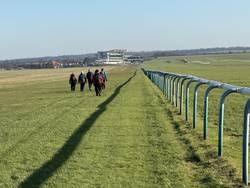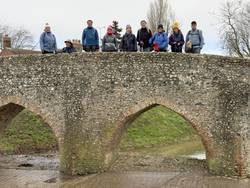Our February trip took us to the Jarman centre in Newmarket. The building is located in a lovely patch of woodland just to the southeast of the town. At the time of our visit, it was carpeted with snowdrops. Owned by the Girl Guides, the building is named after Alice Jarman, who was a generous benefactor in the 1980s. The site was once part of the grounds of Cheveley Park Mansion, a gatehouse for which we passed on our walk into town on the Sunday.
Cheveley Park Mansion was once owned by the same person as the Cheveley Stud, which is still there, and it is clear that horse breeding and racing pretty well dominate the town. On the Sunday we walked into town past the Longhill training grounds, then paused for lunch at the Southfields training grounds before taking a walk across the July Racecourse and the famous Rowley Mile.
Horse racing in Newmarket goes back to 1636. In the 18th century, the Jockey Club leased land in the area and started organised races on the heath where the July Racecourse now stands. It always enjoyed the patronage of the rich and influential, and famously Charles II had a palace in the town (with Nell Gwynne in a cottage a couple of doors down). The Rowley Mile is named after his favourite stallion “Old Rowley”, which also became a nickname for the king himself. The Jockey Club continue to enjoy a royal charter, with King Charles and Queen Camilla the current patrons.
You’ll be glad to hear that we weren’t breaking any rules by walking on the racecourse. When there’s no racing the heath is open for public access from 1pm, and on a Sunday it’s open from 11am. Apparently in the mornings it’s used to exercise about 3000 horses, which I can’t really imagine.
The reason Newmarket was so good for training and racing horses, is the nature of the surrounding hills. These gentle chalk slopes provided just the right gradient for training horses, hence the famous training grounds of Warren Hill and Longhill. In modern times, the same landscape appears to attract numerous red kites, which use the chalk escarpments to catch soaring thermals. We saw plenty of these on our Saturday walk from Moulton out to Dalham and Gazeley. The kites weren’t the only points of interest on this splendid hike through quaint villages. At Dalham we saw a historic malt kiln before heading up the hill to lunch at the church. St Mary’s Dalham has the remains of wall paintings, including bits of the seven deadly sins. Following the collapse of the steeple during a storm, the tower was re-built in 1625. Scratched into two of the supporting pillars are graffiti outlines of postmills, probably carved soon after the new tower was dedicated.
After a chilly day slithering through mud, a warm up in the Packhorse Inn, Moulton, at the end of the walk was more than welcome. The inn is an old one, sited on what was once the main route between Bury St Edmunds and Cambridge, and next to the medieval packhorse bridge over the River Kennett. Built in the 15th century, the bridge has a four arch, 20m span – clearly much bigger than is demanded by the current river flow. Nice to finish the day with a dose of history and a hot cup of tea.
Ali

